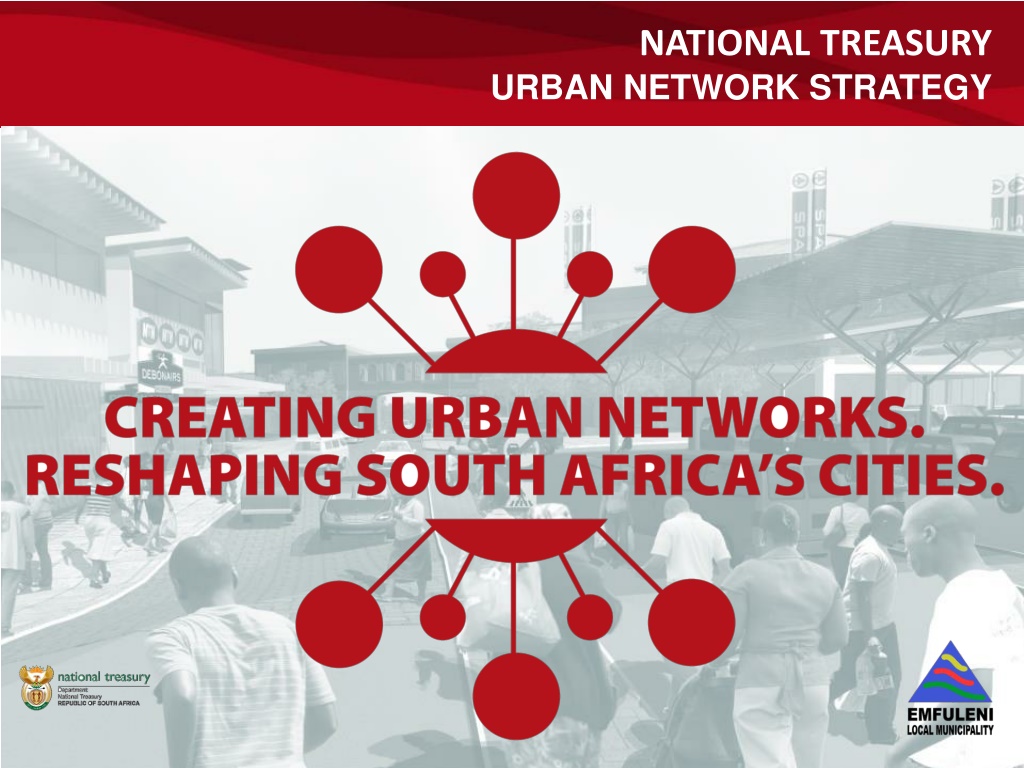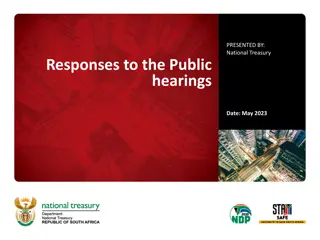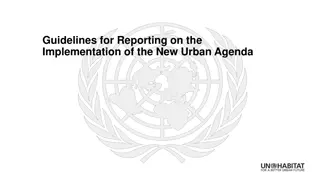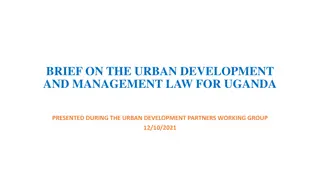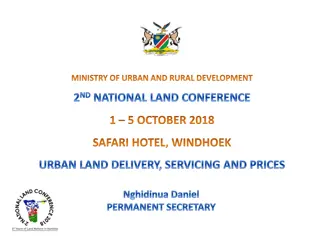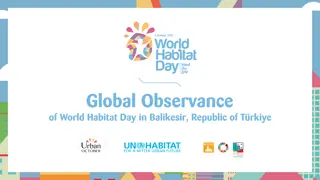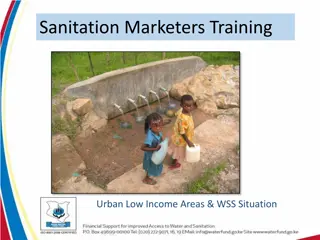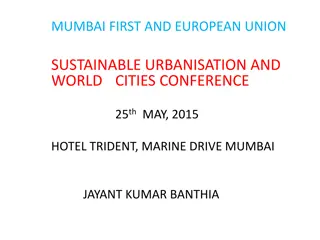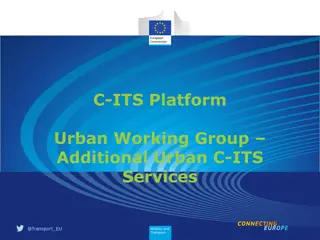National Treasury Urban Network Strategy
The National Treasury Urban Network Strategy focuses on strengthening strategic alignment between Emfuleni Local Municipality and the National Treasury. It emphasizes integrated, equitable spatial and economic development through the Urban Networks Strategy, catalytic interventions, and strategic partnerships. The Neighbourhood Development Programme plays a key role in managing grants for neighborhood development projects, with a focus on improving residents' quality of life. Lessons learned in township regeneration stress the importance of integrated strategies and government involvement. The emphasis is on cities as hubs of socio-economic activity.
Download Presentation

Please find below an Image/Link to download the presentation.
The content on the website is provided AS IS for your information and personal use only. It may not be sold, licensed, or shared on other websites without obtaining consent from the author.If you encounter any issues during the download, it is possible that the publisher has removed the file from their server.
You are allowed to download the files provided on this website for personal or commercial use, subject to the condition that they are used lawfully. All files are the property of their respective owners.
The content on the website is provided AS IS for your information and personal use only. It may not be sold, licensed, or shared on other websites without obtaining consent from the author.
E N D
Presentation Transcript
NATIONAL TREASURY URBAN NETWORK STRATEGY
OUR OBJECTIVES AND AGENDA FOR TODAY Strengthen strategic and practical alignment between Emfuleni Local Municipality and NT: NDGP on the approach to pursuing more integrated, equitable spatial and economic development Focus on spatial urban form and spatial targeting using the Urban Networks Strategy Accelerating catalytic interventions in Emfuleni Local Municipality Objective Strategic partnership based alignment of Emfuleni Local Municipality and NT and implementation of the Urban Networks Strategy This requires clarity on the next steps with: Strategic spatial planning Pipeline of catalytic interventions Desired outcome 2 2
CONTEXT OF THE NEIGHBOURHOOD DEVELOPMENT PROGRAMME The NDP was established in 2006 and is responsible for managing the Neighbourhood Development Partnership Grant. Grant Purpose: To support and facilitate the planning and development of neighbourhood development programmes and projects that provide catalytic infrastructure to leverage 3rd party public and private sector development towards improving the quality of life of residents in targeted underserved neighbourhoods (townships generally) Division of Revenue Bill, 2013 (Bill No. 02 of 2013) From the start of the programme until the end of 2012/13 the NDP has: Approved municipal business plans to a value of R4.0bn Approved project plans to the value of R 3.9 bn. Completed 129 municipal NDP projects Disbursed a total of R615m to service providers and municipalities, 94% of its budget.
NDPG FUNDED URBAN HUBS IN SA CITIES: BRIDGE CITY, ETHEKWINI Magistrates Court Precinct Plan Bridge City Shopping complex Underground Rail Station (PRASA)
NDPG: LESSONS LEARNT IN TOWNSHIP REGENERATION Multiple spatially disparate ad-hoc township projects in the absence of an integrated and co-ordinated city-wide urban regeneration strategy has very low impact All spheres of government need to be involved. Project prioritisation not to be informed by vested interests Private fixed investment is dependant on the above Limited municipal capacity to plan, assemble and align multiple funding sources in single large-scale mixed use development Land issues dictate project progress and viability Opportunities exist to develop and diversify township economies by leveraging mixed-use transit orientated development 5 5
FOCUS IS ON CITIES AS THEY ARE THE CENTRES OF SOCIO-ECONOMIC ACTIVITY 6 6
A TARGETED INVESTMENT PROGRAMME IN SA S 18 LARGER URBAN CENTRES 7 7
URBAN GROWTH MAY DEEPEN INEQUALITY AND EXCLUSION IN OUR CITIES Poverty and unemployment, especially among youth Sprawling, monotonous, dormitory landscapes, with long travel times for poor to access amenities, services & opportunities Compounded by climate change and weak governance, and may result in rising social conflict (service delivery protests) Accelerating economic growth required that we address: future supply side bottlenecks from unavailability of public infrastructure (new, expanded and rehabilitated assets) continued low levels of private sector fixed investment in the built environment 8 8
A MORE STRATEGIC APPROACH IS CRITICAL TO LEVERAGE REAL CHANGE and strategy requires: Need in Consensus on concepts A programmatic approach Strong partnerships marginalised areas GAP Available Public Resources Private fixed investment DIFFERENTIAL
WHY FOCUS ON URBAN SPATIAL FORM? Severe inequality is clearly represented in the spatial form of all our cities Exclusionary (spatial patterns of access to services and opportunity) Inefficient (growing fiscal and economic costs in supporting the current spatial form and design) Unsustainable (severe environmental and social risks) Public policy unwittingly reinforced these divides, and set them in concrete A lack of adequate forward planning to deal with continuing pulling power of cities & environmental factors affecting cities A renewed focus on the quality of urban and economic growth is required 10 10
THE NATIONAL DEVELOPMENT PLAN URGES COORDINATED ACTION The Commission provides a proposed schema for spatial targeting that indicates where investment should be focused, and we identify elements of the existing broad consensus for transforming towns and cities National Development Plan, 2012 Tackle spatial development patterns directly Combine the use of multiple instruments: Strengthen strategic spatial planning Coordinate the use of Planning, regulatory and investment tools and strategies Leverage public transport, infrastructure, land and housing investments Use a spatial focus to target more public resources 11 11
THE URBAN NETWORKS STRATEGY An integrated hierarchy of land use clustering & connectivity
THE NEW APPROACH WILL ENABLE GROWTH & DEVELOPMENT Transit-orientated Partnership-based Targeted (precinct) investment Aimed at strategic spatial transformation Optimise access to social & economic opportunities, especially for the poor Minimise transaction costs to participate in the urban economy Replicable model 13 13
THE TWO SPATIAL PRINCIPLES UNDERPIN THE URBAN NETWORKS STRATEGY I. Primary Network The primary network is at city-wide scale and consists of anchor nodes, i.e. the CBD and a number of Urban Hubs, as well as Activity Corridors between these anchor nodes . II. Secondary Network Secondary Nodes are smaller nodes within township areas connected to the Urban Hub and serving as neighbourhood or lower order nodes. 14 14
. . . IDENTIFY & STRENGTHEN HUBS . . . URBAN NETWORKS STRATEGY 15 15
The urban networks strategy is aimed at integrated growth & development Strong urban network with a hierarchy of well connected nodes Efficient flows of people, goods & information Targeted public infrastructure that catalyses ubiquitous distribution of public & private sector investment Good access to jobs & amenities
INVESTMENT CASE STUDY: MAMELODI Numerous ad-hoc non integrated or aligned projects. Little co-ordination of public funds 19 19
INVESTMENT CASE STUDY: MAMELODI R138m Urban Hub and secondary nodes, spatial logic, spatial targeting results in integrated or aligned projects. Better leverage through the co-ordination of Public funds 20 20
IDENTIFICATION & PLANNING WILL UNLOCK A PIPELINE OF PRIORITISED CATALYTIC PROJECTS Urban Network Network Elements Intervention Investment Phasing Regeneration and management Mixed-use development and management CBD Urban Hubs Spatial Development Objectives Network Connectivity Optimisation Primary Network Primary Transport Link Activity Corridor Secondary Transport Link Develop/Upgrade and management Infill & Densification Secondary Network Develop/Upgrade 21 21
THAT ARE CRITICAL TO THE STRENGTHENING OF THE PRIMARY NETWORK Network Topology: CBD Urban Hubs & Secondary Transport Links Primary Public Transport Links Activity Corridors CBD
FROM STRATEGY TO ACTION Strategic spatial planning Urban network identification & planning Intervention planning Precinct planning Identification of catalytic projects Project Planning Detailed design Pipeline Implementation management Life-cycle Management Performance monitoring and evaluation Precinct management Investment facilitation 23 23
NDPG FUNDED URBAN HUBS IN SA CITIES: MITCHELLS PLAIN 24 24
VIBRANT URBAN HUBS ARE KEY ENTRY POINTS High density, mixed use precinct that contains a diverse variety of land uses, services and activities Function: Town centre for township/s Gateway to the rest of the wider urban area Efficient multi-modal public transport system & a precinct network of public spaces and walkways Leveraging of investment: Retail Recreation, hospitality & tourism Offices, banking Community facilities & govt services Higher density housing Within an urban design framework that promotes a vibrant sense of place in which to live, work and play 25 25
INDIVIDUAL URBAN HUB STRATEGY TO BE DETERMINED VIA INVESTMENT INDEX High Investment 3. On a road to nowhere High Low Diversity No & Type of tenants (Traders, SME s, National Chains) Land Use Mix Private/Public Split 26 26
CBD & HUBS REQUIRE A CLEAR PRECINCT MANAGEMENT STRATEGY TO ENSURE FULL LIFE CYCLE OPTIMISATION Objective: An inclusive, vibrant, safe, investment friendly hub Precinct Management Community Municipality Public Sector Investors Private Sector Investors Developers Traders Tenants Property Owners Economic Development Place marketing Lifestyle event management Risk management Safety o Security presence o Active edges rather than dead zones - e.g. walls & vacant stands Clean and well maintained precinct public spaces 27 27 27 27
AND AN URBAN DESIGN TOOLKIT WILL ASSIST CITIES TO OPTIMISE VIBRANCY & INVESTMENT Identification of spatial structuring elements: Rail & road infrastructure Modal facilities Pedestrian network Public spaces Planning & design principles for: Optimal clustering Making of a qualitative public realm Investment phasing towards private sector leveraging 28 28
CONVERGENCE OF PEOPLE IN HUBS TO ATTRACT PRIVATE SECTOR INVESTMENT 29 29
THE PIPELINE IS AIMED TOWARDS AN INTEGRATED FISCAL PACKAGE Underserved Townships MIG Developed Area SHRZ CBD PTIS NDPG Underserved Townships Underserved Townships UDZ
TIME-FRAMES: PLANNING ENGAGE COMPILE WORK PLAN PREPARE PROGRAMME PLAN PREPARE AREA BASED PLAN Compile Municipal Work Plan Compile Service Provider Work Plan Procure Engage 1 Engage 2 Service Provider Date? Date Date Date Date Date In-progress 3 WEEKS 4 WEEKS 4 MONTHS 2 WEEKS URBAN NETWORK ELEMENTS IDENTIFIED MUNICIPAL WORK PLAN 3 MONTHS 6 MONTHS COUNCIL RESOLUTION MEMORANDUM OF AGREEMENT
KEY ACTIONS AND TIMELINES Stage I: (DATE) Engagement Two (Technical Meeting) Stage II: (DATE) Council (Mayoral Committee) resolution approving participation in the NDPG Institutional / Governance arrangements Confirmed NDPG conditions (Memorandum of Agreement) Urban Network Identification Service Provider procurement & capacity support requirements Stage III: (DATE) Urban Network Plan completed Stage IV: (DATE) Precinct Plan completed Catalytic NDPG projects identified with timeframes 32 32
